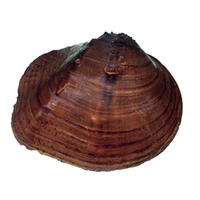Mapleleaf
Scientific name: Quadrula quadrula

Photo: Field Guide to the Freshwater Mussels of Ontario
Status
Special Concern
“Special Concern” means the species lives in the wild in Ontario, is not endangered or threatened, but may become threatened or endangered due to a combination of biological characteristics and identified threats.
Date added to the Species at Risk in Ontario List
The Mapleleaf was already assessed as threatened when the Endangered Species Act took effect in 2008. The species was reassessed as special concern in May 2017.
Read the assessment report PDF.
What it looks like
The Mapleleaf is a medium- to large-sized freshwater mussel that grows 12 centimetres long. Shell colour varies from yellow-green to brown. It somewhat resembles a maple tree leaf due to its square-ish shape and two raised ridges of nodules along the shell that form a “V” outline and resemble the veins in a tree leaf. It also has growth lines (dark bands) that look similar to the rings in a tree stump.
Where it lives
The Mapleleaf is usually found in medium to large rivers with slow to moderate currents and firmly packed sand, gravel, or clay and mud bottoms. It also lives in lakes and reservoirs. Mussels filter water to find food, such as bacteria and algae. Mussel larvae must attach to a fish, called a host, where they consume nutrients from the fish body until they transform into juvenile mussels and then drop off. In Canada, the fish host of the Mapleleaf is the Channel catfish. Presence of the fish host is one of the key features determining whether the body of water can support a healthy mussel population.
Where it’s been found in Ontario
In Canada, the Mapleleaf is found in Manitoba and in southwestern Ontario. In Ontario, this species is found in several large rivers that drain into Lake St. Clair and Lake Erie including the Sydenham, Ausable, Grand, and Thames and Welland rivers. The species has disappeared from Lake Erie and the Detroit and Niagara rivers.
What threatens it
The main threats to the Mapleleaf are habitat destruction largely due to pollution and siltation, which wash into rivers from nearby agricultural and urban developments. The Zebra mussel, which is an invasive species from Europe, is a serious threat because it attaches to other mussels and can kill them by interfering with breathing, feeding, excretion and movement. Conditions that threaten the fish host species also threaten the Mapleleaf.
Action we are taking
Special concern species do not receive species or habitat protection, but may be eligible for grants to help with their protection and recovery.
What you can do
Report a sighting
Report a sighting of an endangered animal or plant to the Natural Heritage Information Centre. Photographs with specific locations or mapping coordinates are always helpful.
Volunteer
Volunteer with your local nature club or provincial park to participate in surveys or stewardship work focused on species at risk.
Be a good steward
- private land owners have a very important role to play in species recovery; if you find a a Mapleleaf on your property, you may be eligible for stewardship programs that support the protection and recovery of species at risk and their habitats
- invasive species seriously threaten many of Ontario’s species at risk; to learn what you can do to help reduce the threat of invasive species, visit:
- you can help improve mussel habitat and keep Ontario’s water safe and clean by maintaining natural vegetation next to creeks and rivers; the roots of plants reduce erosion and can stop soil from washing into the river; fence off streamside areas to keep cattle (and their manure) out of the water; there are many other things that you can do to help reduce soil erosion and you might be eligible for funding assistance - for more information, visit the Ontario Soil and Crop Improvement Association: www.ontariosoilcrop.org
Report illegal activity
Report any illegal activity related to plants and wildlife to
Quick facts
- the Mapleleaf depends on the channel catfish to survive; by attaching itself to the gills of the catfish, the mussel larvae consume nutrients from the fish until they transform into juvenile mussels and drop off
- the Mapleleaf has a lifespan averaging 22 years; a few individual mussels collected from Manitoba were 64 years old
- mussels are indicators of environmental health; because they have complex life cycles, are long-lived and eat by filtering water and its pollutants, mussels provide a snapshot of how healthy our waterways are
- aboriginal people harvested mussels for food; they also used the shells to create jewelry and tools; in the 1800s, massive numbers of mussels were harvested from the Grand River to create buttons - millions were shipped out every year until the 1940s when plastic buttons became more popular